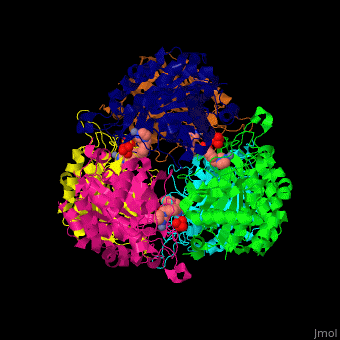Glutaminyl cyclase
From Proteopedia
(Difference between revisions)
| Line 7: | Line 7: | ||
== Relevance == | == Relevance == | ||
| - | The biological assembly of Human Glutaminyl cyclase is <scene name='59/596314/Cv/ | + | The biological assembly of Human Glutaminyl cyclase is <scene name='59/596314/Cv/6'>homohexamer</scene>. QC is considered as a marker of thyroid tumors. QC acts on the generation of N-terminal pyroglutamyl groups of peptide hormones and amyloid-related plaque-forming peptides. The latter contributes to Alzheimer disease. Alzheimer patients show increased expression of QC<ref>PMID:23207485</ref> and QC inhibitors reduces the disease pathology and symptoms. |
== Structural highlights == | == Structural highlights == | ||
| - | The <scene name='59/596314/Cv/ | + | The <scene name='59/596314/Cv/7'>active site of QC contains a Zn+2 ion</scene><ref>PMID:16135565</ref>. |
</StructureSection> | </StructureSection> | ||
Revision as of 10:20, 2 April 2019
| |||||||||||
3D Structures of glutaminyl cyclase
Updated on 02-April-2019
References
- ↑ Busby WH Jr, Quackenbush GE, Humm J, Youngblood WW, Kizer JS. An enzyme(s) that converts glutaminyl-peptides into pyroglutamyl-peptides. Presence in pituitary, brain, adrenal medulla, and lymphocytes. J Biol Chem. 1987 Jun 25;262(18):8532-6. PMID:3597387
- ↑ Valenti MT, Bolognin S, Zanatta C, Donatelli L, Innamorati G, Pampanin M, Zanusso G, Zatta P, Dalle Carbonare L. Increased glutaminyl cyclase expression in peripheral blood of Alzheimer's disease patients. J Alzheimers Dis. 2013;34(1):263-71. doi: 10.3233/JAD-120517. PMID:23207485 doi:http://dx.doi.org/10.3233/JAD-120517
- ↑ Huang KF, Liu YL, Cheng WJ, Ko TP, Wang AH. Crystal structures of human glutaminyl cyclase, an enzyme responsible for protein N-terminal pyroglutamate formation. Proc Natl Acad Sci U S A. 2005 Sep 13;102(37):13117-22. Epub 2005 Aug 31. PMID:16135565

